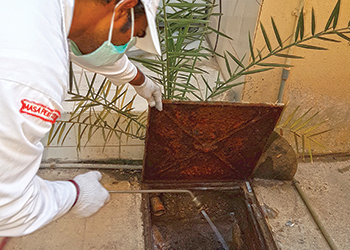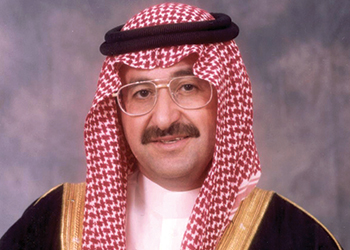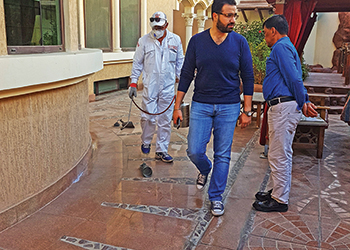
 A Masa technician sprays a manhole to kill cockroaches.
A Masa technician sprays a manhole to kill cockroaches.
A comprehensive pest management programme will ensure that drains and sewers do not become health hazards, as Masa entomologist MIRZA WAQAR AHMAD reveals.
Sewerage and drainage systems provide an optimum environment for pests to thrive in; they provide food and water, and shelter from weather conditions, thereby fulfilling their basic needs to survive.
These passages also provide access points for pests to gain entry into residential, commercial and other areas. Not surprisingly, cockroaches are the most common inhabitants of the sewer systems, given the conditions inside that help them thrive and multiply. Therefore, a full-fledged pest management programme is important to control these pests within the system.
Research by Noureldin and Farrag (2010) indicates there are four species of cockroaches found in Saudi Arabia: German, American, Brown-banded and Oriental. Of these, the German cockroach is the most predominant with 98.8 per cent occurrence in dwellings, and 97.7 per cent in properties.
According to the World Health Organisation (WHO), cockroaches can be vectors of diseases, such as dysentery, salmonellosis hepatitis A, poliomyelitis, and legionnaire disease; and are also important provokers of asthma.
The sewerage conditions and housekeeping practices influence the severity of cockroach infestations, which are fostered by the presence of food through improper storage or disposal, leaking pipes and taps, and points of entry such as cracks, crevices and holes in plasterwork and flooring.
 |
|
Mousaied Alshieshakly, owner and general manager of Masa. |
The design and utility of sewers makes it substantially difficult to eliminate tiny pests such as cockroaches. Threats of accumulation of gutter gases require the provision of openings, which allow cockroaches to enter. Entry points for drains maintenance offer further opportunities for pests.
Many cockroaches are flushed down the toilets after pest control. But if the cockroaches have been treated with ineffective pesticides, they may subsequently recover in the sewer system.
Furthermore, the joint sewers where sanitary and surface drainage assemble together, offer further opportunities for pests to enter and survive. In such cases, every drain and gutter provides entry to the system.
Masa Establishment has carried out a variety of cockroach management projects in sewers and drains both small scale, concentrating on manholes and inside connections in single premises and big scale municipal programmes for cockroaches in a large network of gutters.
Generally, measures taken in single premises will have negligible impact on the cockroach population in an entire sewerage system, but they can reduce the invasion of those premises from the sewers. Replacing broken or ill-fitting manhole covers helps in decreasing the passageway for cockroaches, but the necessary sewer openings cannot be closed, and screening against rodents will not prevent passage of cockroaches.
Masa’s pest control professionals carry out residual surface treatments by using Pyrethroid insecticides labelled for cockroach control, containing active ingredients such as Deltamethrin, Beta-Cyfluthrin and Cypermethrin. Cockroach management is differentiated into two categories: the first is regarded as knock-down treatment, and the second as routine or follow-up treatment.
 |
|
Masa’s inspection team ensures quality of service with on-spot training. |
For large-scale operations involving treatment of manholes and the connecting sewer lines between manholes or along vent pipes, it is customary to use appropriate residual insecticide dust. Such dusts can be blown down the shafts along sewer lines, killing every cockroach en route.
In the past, a traditional way of dusting sewers was to inject dust down a manhole using power dusters and to keep applying until it emerged from an opened manhole 100 to 200 yards away. This procedure was repeated along the required length of the sewer line. Nowadays, however, there are specific limits on how much dust is blown down each manhole.
The use of insecticide dusts avoids the need to open and treat every manhole shaft thus saving time. It is also not practical to individually treat every manhole because of jammed covers or parked vehicles. Sewer maps are an essential tool in the planning and follow-up of large-scale programmes.
Apart from the critical pesticide safety aspects, Masa gives priority to the physical safety of its pest management personnel. Since sewers are intrinsically dangerous places, Masa chooses possible methods that don’t require entering the manholes.
Furthermore, full safety precautions should be taken by wearing chemical-resistant gloves, an approved respirator, goggles and long-sleeved clothing (coverall). Other obvious safety aspects include using the proper tools for lifting manhole covers and safeguarding traffic and pedestrians from open manholes. When conducted carefully and with the right materials and methods, cockroach control in sewers is a valuable component of the urban pest management.
Masa uses a term “strategy” in the context of cockroach control, which commits towards a comprehensive approach tailored to the management of a particular situation. It also reflects the company’s intent to win against pests by following international standards set by world renowned associations, such as National Pest Management Association (NPMA) and the British Pest Control Association (BPCA).





















_0001.jpg)


.jpg)
















.jpg)








.jpg)


